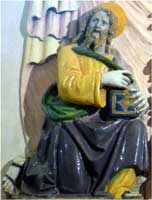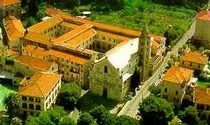madonna of milk
Documents
2.MADONNA OF MILK
(click on the photos)
We read in an inventory of 1770 that in the sacristy there was a stucco altar with a Robbian group above it with the Image of the Blessed Virgin and some Saints [1].  In those pages it was specified that in 1760 important works had been done in the new sacristy and that at the same time, in addition to recovering the Robbian ceramic from the old sacristy, the espaliers (of the choir seats), also worked by Fra Antonio from Venice: those six splendid inlay works that we call today marquetry.
In those pages it was specified that in 1760 important works had been done in the new sacristy and that at the same time, in addition to recovering the Robbian ceramic from the old sacristy, the espaliers (of the choir seats), also worked by Fra Antonio from Venice: those six splendid inlay works that we call today marquetry.
 In those pages it was specified that in 1760 important works had been done in the new sacristy and that at the same time, in addition to recovering the Robbian ceramic from the old sacristy, the espaliers (of the choir seats), also worked by Fra Antonio from Venice: those six splendid inlay works that we call today marquetry.
In those pages it was specified that in 1760 important works had been done in the new sacristy and that at the same time, in addition to recovering the Robbian ceramic from the old sacristy, the espaliers (of the choir seats), also worked by Fra Antonio from Venice: those six splendid inlay works that we call today marquetry.Today in the sacristy those inlays are still there, but - against the south wall - instead of the stucco altar there is a massive walnut counter containing sacristy equipment, and above this counter - hanging on the wall - there are three display cases with a good number of relics.
Higher up, the whole wall is dominated by the Madonna of milk, with two saints kneeling on the sides: the one on the left older, the one on the right younger.
Both the Madonna del latte and the 2 saints are Robbiane (1520-1525, approximately), attributed to the Bottega di Giovanni della Robbia.
Let's examine them individually:
1-The Madonna of milk is in a niche, adorned with a vegetable festoon loaded with fruits and foliage. It is a statue of Mary with baby Jesus and above the statue there is also a dove with spread wings, symbol of the Holy Spirit.
The Madonna is represented seated, with the Child on her knees, but with a marked peculiarity: Mary is offering her right nipple to the Baby.
The first official iconographic representations of the "Madonna del Latte" are found in Egypt, now Christianized, of the VI or VII century after Christ, where Mary is portrayed while breastfeeding the Baby Jesus or is about to do so.
But these are still very stylized images that above all allude rather than show.
But it is in the early fourteenth century that the iconographic representation of the "Madonna of milk" loses its stylized characteristics in favor of a more realistic representation. The humanization of the Madonna and child met with the favor of the faithful and the sacralization of the act of breastfeeding a child convinced women to identify themselves more by involving them also emotionally.
The cult of the Madonna of milk spread throughout Europe and especially in the countryside.
For about two centuries there were numerous famous artists who ventured into sacred representation.
One name is enough: Leonardo da Vinci, with his famous Madonna Litta (Hermitage Museum, St. Petersburg).
It was the Council of Trent (started in 1543) that considered these images inconvenient, because the representations of Mary with bare breasts could divert the faithful from prayer.
So the artists stopped dealing with this subject, which - for obvious reasons - would no longer be required.
But of those distant centuries some works of this kind have been preserved, as happened in our small abbey, where kings and emperors, cardinals and popes have passed. (Here on the left Madonna Litta).
There is still a problem with the two characters we see kneeling beside the milk Madonna.
There is no doubt about the identity of the youngest (the one on the right): it is the Evangelist St. John: he is the only one who reports the episode of the Wedding at Cana, where the intercession of Mary played an important role in starting the public mission of Jesus (and also in solving the embarrassing problem of the lack of wine in that wedding banquet). Furthermore, it is precisely to the young apostle John that Jesus, dying on the cross, entrusted his Mother.
And he took care of it, like a son.
The identity of the oldest one (on the left) has been discussed for centuries between two evangelists: is it Luke or Matthew?
 But Luke was not a Jew, but a pagan (probably of Antioch in Syria) of Greek culture: one of the first converts to Christianity and who, with exemplary enthusiasm, had started to write about it, to make it known: in fact, they owe him, in addition to his Gospel, also the Acts of the Apostles: a narration of the hardships and successes of the church that took its first steps in the apostolic era.
But Luke was not a Jew, but a pagan (probably of Antioch in Syria) of Greek culture: one of the first converts to Christianity and who, with exemplary enthusiasm, had started to write about it, to make it known: in fact, they owe him, in addition to his Gospel, also the Acts of the Apostles: a narration of the hardships and successes of the church that took its first steps in the apostolic era.
Luke speaks a lot about the Madonna, even before the birth of the Child, and then about the childhood of Jesus.
It is he who reports the anguish of Mary and Joseph for the loss of his twelve-year-old son in Jerusalem.
All very personal information he must have received directly from Maria.
 But Luke was not a Jew, but a pagan (probably of Antioch in Syria) of Greek culture: one of the first converts to Christianity and who, with exemplary enthusiasm, had started to write about it, to make it known: in fact, they owe him, in addition to his Gospel, also the Acts of the Apostles: a narration of the hardships and successes of the church that took its first steps in the apostolic era.
But Luke was not a Jew, but a pagan (probably of Antioch in Syria) of Greek culture: one of the first converts to Christianity and who, with exemplary enthusiasm, had started to write about it, to make it known: in fact, they owe him, in addition to his Gospel, also the Acts of the Apostles: a narration of the hardships and successes of the church that took its first steps in the apostolic era.Matthew, on the other hand, is an authentic Jew, personally called by Jesus, when he was still a public sinner, acting as a tax collector, on behalf of the hated Romans.
He narrates in his Gospel the personal experiences he had in the three years spent with Jesus and the other 11 apostles, traveling up and down Palestine and its surroundings. He had been an eyewitness to many episodes in the life of Jesus and had personally heard many words and speeches about it. He also knows many facts involving the Madonna: birth of Jesus in Bethlehem, the shepherds, the Three Wise Men, the mysterious star of the East, Herod, the massacre of the innocents, the flight to Egypt, the establishment of the family, then returned in Palestine, in Nazareth.
The question remains open!
I once asked our well-known historian and monk from Finalpia, Father Gregorio Penco, what he personally thought of it.
He surprised me by replying that there was also a further hypothesis: the oldest could represent the Old Testament and the younger the New Testament ...
Veterum sapientia vel prudentia? (Ancient wisdom or common sense?)
FINAL NOTE,
The crown at the top, from which two curtains depart, the flying angels, with various putti ... are all eighteenth-century scenic superstructures, which respond to the tastes of a very interesting era, but which has little to do with Renaissance culture that produced works like our Robbiane.
-----------
(1)See G. Salvi, The sanctuary of Our Lady in Finalpia, on unpublished documents, Subiaco, 1910, p. 51-52




